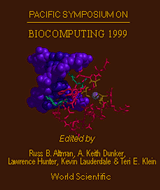Extension of refractoriness in a model of cardiac defibrillation
Trayanova NA, Aguel F, Skouibine K
Department of Biomedical Engineering, Tulane University, New Orleans, LA 70118, USA.
Pac Symp Biocomput. 1999;:240-51.

Abstract
This simulation study presents an inquiry into the mechanisms by which a strong electric shock halts life-threatening cardiac arrhythmias. It examines the "extension of refractoriness" hypothesis for defibrillation which postulates that the shock induces an extension of the refractory period of cardiac cells thus blocking propagating waves of arrhythmia and fibrillation. The present study uses a model of the defibrillation process that represents a sheet of myocardium as a biodomain with unequal anisotropy ratios. The tissue consists of curved fibers in which spiral wave reentry is initiated. The defibrillation shock is delivered via two line electrodes that occupy opposite tissue boundaries. Simulation results demonstrate that a large-scale region of depolarization is induced throughout most of the tissue. This depolarization extends the refractoriness of the cells in the region. In addition, new wavefronts are generated from the regions of induced hyperpolarization that further restrict the spiral wave pathway and cause its termination.
[Full-Text PDF] [PSB Home Page]